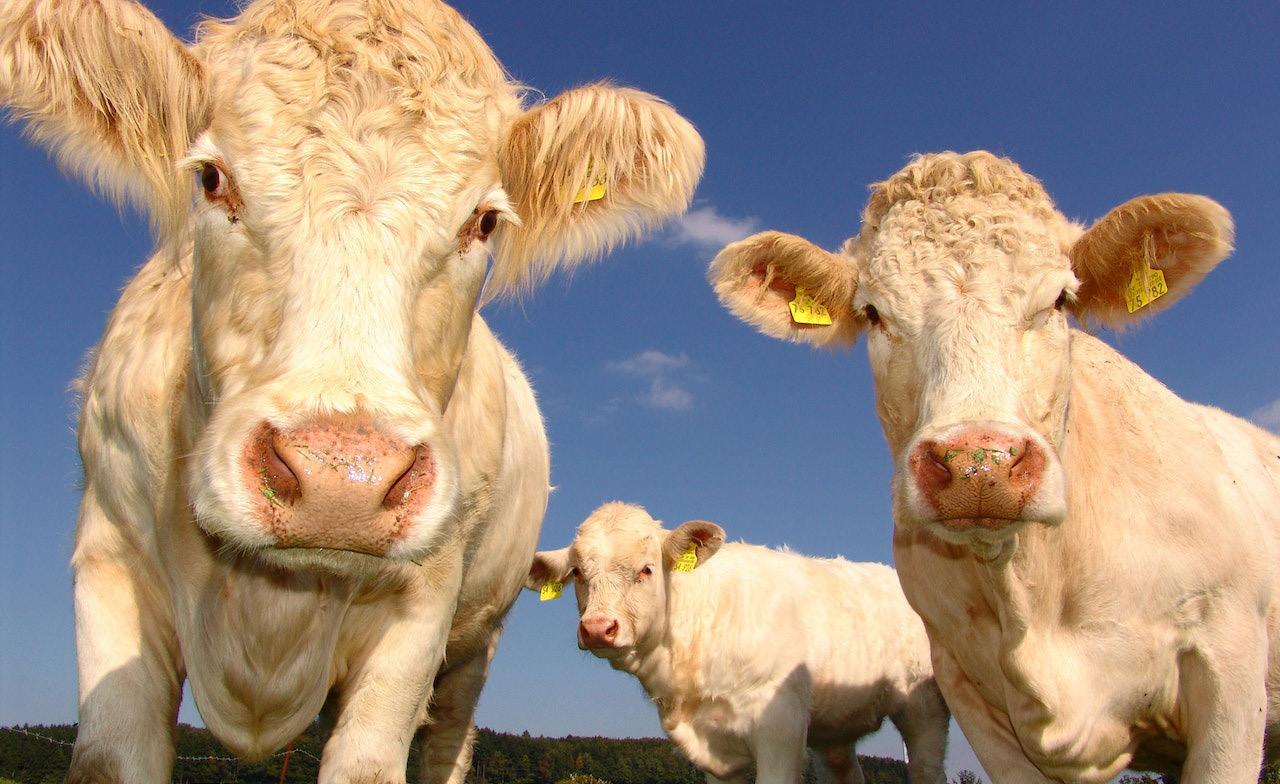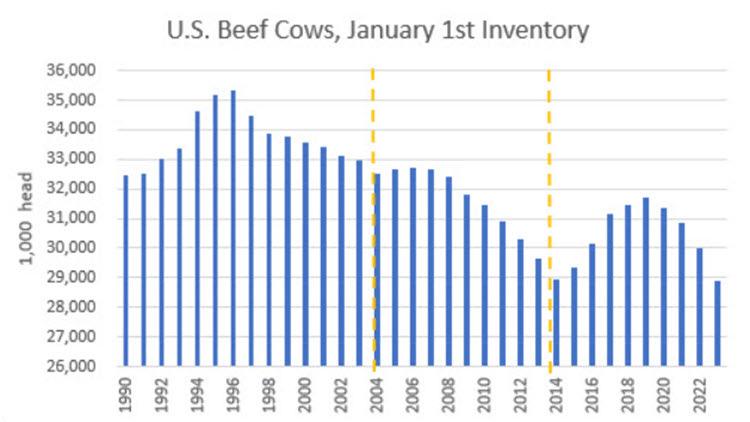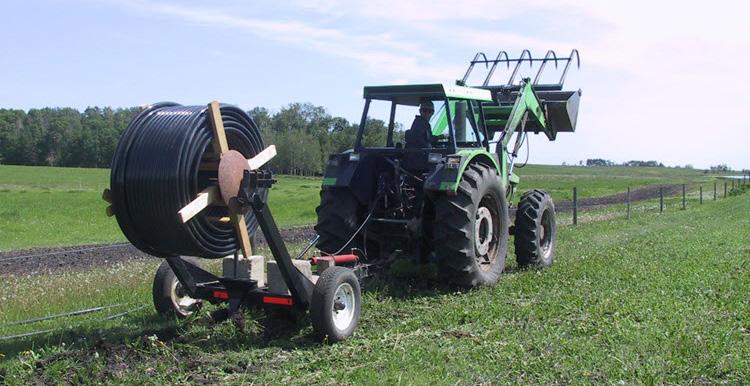
10 minute read
Supporting Sustainability in Agriculture
addressing the unique challenges of farming in Alberta. Alberta's producers are among the best in the world when it comes to sustainable practices, and we will continue to support their efforts to feed the world while protecting the environment for generations to come.” agement programs to help them manage significant risks that threaten the viability of their farms and are beyond their capacity to manage.
Quick facts
Advertisement
The new Sustainable Canadian Agricultural Partnership will support the continued growth and prosperity of Alberta’s agriculture sector.
In Alberta, the partnership represents $508 million in funding over five years that will provide grants to programs that support the needs of Alberta’s agriculture and agri-food sector.
Alberta’s programs will aim to create new jobs and spur growth in the agriculture sector by supporting value-added processing competitiveness, attracting new investment and expanding irrigation capacity that will boost crop production.
"The new Sustainable CAP provides flexibility to deliver programs that will help producers grow their business and improve productivity while
Nate
Horner,
Minister of Agriculture and Irrigation
“The Sustainable Canadian Agricultural Partnership is an ambitious way forward while we collaborate to ensure economic, environmental and social success for the sector. This historic investment will help producers and processors in Alberta to innovate, to grow, to prosper and to be competitive.”
Marie-Claude Bibeau, Minister of Agriculture and Agri-Food Canada
The programs will also continue protecting plant and animal health and animal welfare, managing risks to Alberta’s natural resources and investing in producer-led agriculture research.
Producers also have access to an enhanced suite of business risk man-
Affects of Climate Change on Agriculture
Climate Change can have several impacts on agriculture. These include:
Changing Weather Patterns: Increased temperatures, altered precipitation patterns, and extreme weather events like droughts and floods can disrupt crop growth, leading to reduced yields and economic losses.
Shifts in Growing Seasons:
Climate change can cause shifts in growing seasons, affecting planting and harvesting times, which may challenge the adaptability of certain crops.
Pest and Disease Outbreaks:
Rising temperatures can promote the proliferation of pests and diseases, putting crops at greater risk and increasing the need for pesticides.
Water Availability:
Changes in precipitation patterns can result in water scarcity or excess, affecting irrigation practices and the overall water availability for crops.
Decreased Crop Quality:
High temperatures during critical growth stages can lead to decreased crop quality, impacting nutritional content and market value.
Loss of Biodiversity:
Climate change can threaten native plant and animal species, disrupting pollination and reducing natural pest control mechanisms.
Food Security
The combination of these impacts can ultimately affect global food production and availability, leading to food security challenges, especially in vulnerable regions.
Addressing climate change and implementing sustainable agricultural practices are crucial for mitigating these effects and ensuring food security in the future.
In total, the Sustainable Canadian Agricultural Partnership (Sustainable CAP) is a five-year, $3.5-billion investment by Canada's federal, provincial and territorial governments that supports Canada's agri-food and agri-products sectors. This includes $1 billion in federal programs and activities and a $2.5-billion commitment that is cost-shared 60 per cent federally and 40 per cent provincially/territorially for programs that are designed and delivered by provinces and territories.
Compared with the current partnership, which expires at the end of the month, there is a $500-million increase in cost-shared funding. Half of this additional funding will help develop and implement the Resilient Agricultural Landscape Program, which will support carbon sequestration, and protect grasslands and wetlands on agricultural lands.
The Sustainable Canadian Agricultural Partnership comes into effect April 1 and replaces the Canadian Agricultural Partnership (CAP).
Sustainable CAP represents the fifth pan-Canadian agreement on agriculture, agri-food and agribased products policy. It replaces CAP (2018-2023), Growing Forward 2 (2013-2018), Growing Forward (2008-2013) and the Agriculture Policy Framework (2003-2008).
On March 6, the federal government announced that applications are being accepted for federal programs under Sustainable CAP that will take effect on April 1.
The Sustainable CAP framework provides flexibility for Alberta to develop and deliver programs that are aligned with the needs of Alberta’s agriculture and agri-food sector and Government of Alberta priorities. Programs will align with five priority areas:
• building sector capacity, growth and competitiveness
• climate change and environmental protection
• science, research and innovation
• market development and trade
• resiliency and public trust
Office Caretaker
The County of Two Hills has a temporary part-time Office Caretaker position available. This position will be a three-month contract for cleaning services at the County of Two Hills Main Office and Gas Utility Office with the possibility of extension following the contract term.

The successful candidate will take on all general cleaning services for the Main Office building (approximately 1-2 hours per day) and the Gas Utility building (2 hours per week) per direction of administration.
Hours will take place between 8:30am – 4:30pm Monday to Friday excluding any Statutory Holidays.
Please forward your resume to:
Sally Dary, CAO
County of Two Hills
Box 490
Two Hills, AB T0B 4K0
Ph:780.657.3358
Email: sdary@thcounty.ab.ca
Submissions will be accepted until a suitable candidate is found.
The County of Two Hills thanks all applicants for their interest. However, only those who have been selected for an interview will be contacted.
Can Canada see beef herd expansion in 2023?

Expansion is dependent on increased profits for the cow-calf sector.
“Any expansion will be dependent on this year’s weather, feed costs and conditions in the second half of 2023,” explains Ann Boyda, provincial livestock market analyst with the Alberta government. “Expansion is dependent on increased profits for the cow-calf sector.”
Calf (550 pound) and feeder cattle (850 pound) prices have reached highs not reported since 2015. With anticipated tighter feeder cattle supplies, prices continue to climb. Cost of gain is also improving due to lower barley prices.
“These conditions may have producers retaining or purchasing heifers or retaining females that they may have otherwise culled,” says Boyda.
Data from CanFax reports Western Canada bred heifer prices in February and March 2023 at levels of 30% to 40% higher than the same period in 2022. Slaughter volume of heifers for the first 3 months of 2023 was 15.4% lower than the same period in 2022. However, slaughter volume of cows remained 11.5% higher over the same period.
“To help gain further insights into prospects for herd expansion, we look at the cattle cycle for a longerterm perspective. A cycle is defined as the period from the low point in inventory, through the peak and back to the next low point. These cycles typically run between 8 and 10 years.”
Beef cow January inventories as reported by Statistics Canada have been declining since 2005. Although there have been short-lived periods of rebuilding from 2016 to 2019, the herd again faced more contraction. The January 1, 2023 beef cow herd at 3.56 million head was down 2.5% from the previous year, approaching the lowest level since 1990.



“If more rainfall returns to Alberta this summer, producers may retain more heifers. But weather is not the only challenge. Issues of agricultural labour shortages and an aging producer demographic persist,” explains Boyda.

The U.S. beef cattle cycle is more identifiable. Expansion between 2014 and 2018 was followed by the current contraction phase. The U.S. beef herd is in the ninth year of its current cycle. The January 1, 2023 U.S. beef cow inventory at 28.9 mil- lion was reported to be 3.6% lower than U.S. beef cow inventory from the previous year. This inventory is the lowest level in nearly 60 years. The continued contraction was attributed to drought conditions and record high prices for feed.
“Increased liquidation through 2022 implies tighter supplies for 2023. Cattle and beef prices may remain strong which could encourage rebuilding. Despite inflation- ary pressures, consumers are still demanding this preferred protein. With grilling season around the corner, prices should remain strong into summer,” says Boyda.
Oat price outlook improves
If the latest acreage estimate is accurate, the result could be price supportive to oats for the next crop year.
OnJune 28, Statistics Canada released its updated 2023 Canadian crop acreage estimates. Among the farmer survey-based numbers was a reduction from earlier estimated Canadian oat acreage of 3.057 million acres to 2.537 million acres.
“Oat prices have dropped sharply from the record prices of a year ago, resulting in a producer reaction to reduced oat acreage,” says Neil Blue, provincial crops market analyst with the Alberta government. “If the updated acreage estimate is proven out and, depending on the weather-dependent oat yield, the result could be price supportive to oats for the next crop year.”
In its most recent June projection, Agriculture Canada had estimated Canadian oat ending stocks at August 1, 2023 of 1.25 million tonnes, up sharply from the tight 333,000 tonnes as of July 31, 2022. Using the recent 3-year average of oat acreage harvested as grain at 85% of seeded acreage, oat harvested acreage would be about 2.16 million acres.
Applying Agriculture Canada’s June forecast 2023 oat yield of 1.428 tonnes/acre (92 bu./acre), Canada’s
2023 oat production would total 3.1 million tonnes. That compares to the June production estimate of 3.64 million tonnes.
“Prior to the Statistics Canada 2023 oat acreage update, Agriculture Canada had estimated 20232024 crop year oat ending stocks at one million tonnes, still likely to be price restrictive,” explains Blue.
However, considering the revised oat acreage, if the 2023-2024 demand estimate of 3.9 million tonnes is realized, Canadian oat carryover could drop down to 500,000 tonnes at the end of July 2024.
“Considering weather challenges across the Prairies this year, there is uncertainty of 2023 oat yields achieving the 1.4 tonne/acre (92 bu./ acre) level. On the demand side, at the discounted price of oats compared to other feed grains, significant oat volumes are still being fed. In addition, 2023 U.S. oat acreage was reduced. Despite the higherthan-expected 2023 U.S. corn acreage potentially leading to greater feedgrain supply, the oat price outlook is more positive for the next crop year,” says Blue.
Benefits of installing shallow buried pasture water pipelines
Shallow buried pasture water pipelines may be an excellent option for watering livestock on pasture. “When water sources are diminished due to lack of quantity or quality, shallow buried pasture water pipelines should be considered as a practical and economical way to supply livestock with water on pasture,” says Shawn Elgert, agricultural water engineer with the Alberta government. “Instead of constructing a dugout where the runoff is not consistent or dependable, a pasture pipeline can bring the water to the cattle instead of forcing the cattle to go the water.”
High Costs of Farming in Alberta
Farming in Alberta can be associated with high costs due to various factors including:
Climate and Weather:
Alberta's climate is characterized by cold winters and short growing seasons, which can require additional expenses for heating, irrigation, and crop protection against frost or extreme weather events.
Input Costs:
The costs of agricultural inputs such as seeds, fertilizers, pesticides, and fuel can be substantial, impacting the overall expenses for farmers.
Land Prices:
The cost of acquiring and leasing farmland in Alberta has been rising, especially in areas with high agricultural productivity, adding to the financial burden for farmers.
Labor and Machinery: Labor costs, as well as the expenses associated with maintaining and upgrading farm machinery and equipment, can significantly contribute to the overall farming expenses.
Water Management:
Depending on the location and type of farming, accessing and managing water resources can be costly, especially during periods of water scarcity.
Transportation and Distribution: Transporting agricultural products to markets can be expensive, particularly for farmers in remote or rural areas.
Commodity Price Fluctuations:
The volatile nature of commodity prices for crops and livestock can impact farm revenues and profitability, affecting the financial viability of farming operations.
Regulations and Compliance:
Compliance with environmental regulations, safety standards, and other legal requirements may necessitate additional investments and ongoing costs.
To address these challenges, farmers in Alberta often adopt innovative farming techniques, explore government support programs, and focus on sustainable practices to manage costs and enhance productivity. Additionally, agricultural policies and market dynamics can also influence the overal cost of farming in the region.
Shallow buried pasture water pipelines have many benefits, such as improving animal health and performance by providing clean and fresh water, reducing soil erosion and nutrient runoff by providing an alternative to accessing natural water sources, enhancing pasture productivity and quality by enabling rotational grazing and better distribution of manure, saving time and labour by eliminating the need to haul water, and increasing land value by adding permanent water infrastructure.
These pipelines are designed to be used during the frost-free part of the pasture season. They are polyethylene pipes that can be installed between 6 and 30 inches below the ground and can deliver water from a pressurized source (such as a dugout, well, or municipal line) to a trough or a tank.
The pipes are usually one to two inches in diameter, depending on the length and demand of the system. The pipes can be installed using a plow or a ripper that cuts a narrow furrow in the soil and places the pipe in it. The furrow is then closed by running a tractor tire over it.

“High Density Polyethylene (HDPE) pipes are recommended as they can withstand rupture from water freezing inside the pipe,” explains Elgert. “If spring watering is desired, it is advised to blow the lines out in the fall after using, as the lines can take some time to thaw in the spring. If the line is as deep as 30 inches, it is harder to remove if maintenance is required.”
Selecting a larger diameter pipe than required for flow rates can help reduce energy requirements as well as installation problems (for ex- ample, if a rock has created a kink in the line). Companies that install these types of pipelines often get a better deal on the pipe as they purchase large quantities, so producers should consider hiring a company install it.
Alberta Agriculture and Irrigation has a pipeline plow available and free to use. For more information on the pipeline plow, contact 310FARM and ask to speak with a water specialist. A tractor with at least 100 horsepower is recommended to use with this plow. To avoid any surprises during installation, one pass should be made with the plow before installing the pipe.
“The design and installation of shallow buried pasture water pipelines depend on several factors, such as location and capacity of the water source, distance and elevation of the pasture, number and type of livestock, layout and size of the troughs or tanks, soil type and topography, and availability of power and equipment.”
Other general tips for designing and installing shallow buried pasture water pipelines include the following:
• Avoid rocks, stony ridges, or other obstructions that can damage the pipe or reduce the water flow.
• Joints where needed should use proper connection methods such as fusing the pipes together.
• The system should be tested for leaks and proper operation before being used.
“Shallow buried pasture water pipelines may be an excellent option for watering livestock on pasture,” says Elgert. “They can improve animal welfare, environmental stewardship and farm profitability. And, with proper planning and assistance, they can also be installed easily and inexpensively.”
(Source: Alberta.ca)











